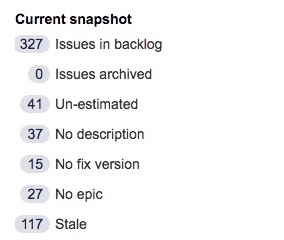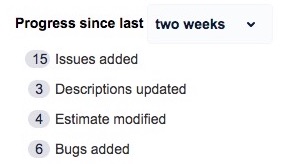2.How to manage your Backlog
Your Backlog is a single, prioritized list of all of your team’s work.
Unfortunately, Backlogs can get out of hand. They can turn into large wishlists that are hard to manage and the work that actually does need to get done might not have enough detail.
Agile Backlog Tools will assist with these problems by providing you a variety of ways to highlight issues in your Backlog that require extra refinement or shouldn’t be there at all. Once you find those issues, you can start refining!
3.Finding issues needing refinement
Issues in your Backlog can become unhealthy. Some issues may not have been updated in a while. Other issues might not have a description, an estimate, a version or an epic assigned to them. In other words, your issues need refinement.

To find unhealthy Backlog items, use the buttons at the top of the page to highlight the following types of issues:
- Any unhealthy issues highlights issues which are missing any of the following: description, estimate, fix version or epic.
- No description highlights issues which do not have a description.
- No estimate highlights issues that have not been estimated.
- No fix version highlights issues which have no fix version assigned.
- No epic highlights issues which have not been assigned to an epic via the ‘Epic link’ field.
- Stale highlights issues which were last updated over 90 days ago.
4.Adding issues inline
You can now add issues inline by:
- First, going to the top of your Backlog
- Then, selecting an issue type
- Type a summary
- Press ‘Enter’ on your keyboard

5.Editing issues inline
Managing a Backlog can turn into a back and forth between dozens of tabs in your browser. This can be confusing and lead to an overwhelming amount of context switching.

With Agile Backlog Tools, you can edit your issues inline in the one place. Currently, you can inline edit an issue’s:
- Summary
- Version (Fix version)
- Epic (Epic link)
- Estimate in story points or hours depending on how you have configured your board
6.Archiving issues

- Over 90 days ago
- Over 180 days ago
- Over 365 days ago
Don’t worry, your issues won’t be deleted. They’ll simply move to a list at the bottom of your Backlog called Archive. From there, you can bring individual issues back to your Backlog.
7.Seeing a current snapshot of your Backlog
As you are refining your Backlog and highlighting different issues to focus on, these selections will be reflected in the ‘Current snapshot’ side panel in your backlog.

This is updated in real time and helps you to identify the current state of your Backlog.
8.Viewing your backlog progress
Backlogs are constantly evolving. The aim is to keep your Backlog relevant as time goes by, but sometimes the ball gets dropped when we’re overloaded or other priorities pop up.

To see how your Backlog has evolved over the last week, two weeks or month, simply switch between the timeframe on the right of your Backlog.
9.Troubleshooting
9.1.Assumptions
Agile Backlog Tools works off a number of key Jira configurations and set up conditions outlined below.
9.1.1.Permissions
To use the Agile Backlog Tools (and all of its functionality) for a board in your Jira instance, you will need to have specific permissions set up for your Jira user account. Most of these permissions will come as default when you have access to a project and its boards in Jira.
- To view a board
- User who can view shaved filter board is based on and have Browse project permission for the project(s) whose issues are shown on the board
- To reorder/rank issues
- Schedule Issues permission and Edit Issues permission
- To add/remove issue to epic and/or to add/remove issue to version
- Edit Issues permission
- To create a version
- Project Admin permission or Jira Admin permission
- To create an epic
- Create Issues permission
9.1.2.Issue types you can see in your Backlog
- You can see any standard issue types (e.g. story, bug, task, or create a new standard issue type)
- You cannot see issue type sub-tasks (sub-tasks are typically created during the break down of Product Backlog Items during Sprint Planning)
- You cannot see the standard issue type ‘Epic’
9.1.3.Board compatibility
We currently support Scrum and Kanplan boards (Cloud only). If you are using a Classic project with the Kanban template, or a Next-gen project, use the links below to enable your Product Backlog:
For Classic projects with the Kanban template:
For Next-gen projects:
https://support.atlassian.com/jira-software-cloud/docs/enable-the-backlog/
10.Licensing FAQ
10.2.How long can I evaluate before purchasing?
You can try the app with no limitations for 30 days, completely free.
10.3.Can I purchase this just for small team in my Jira instance?
No. Atlassian Marketplace for Cloud apps uses Jira instance licensing. You cannot buy an app for a single team or a subset of your Jira instance.
10.4.I have another problem with my license, can you please help?
No worries. For any issues, let us know on our support page or send us an email at support@axisagileapps.com.

